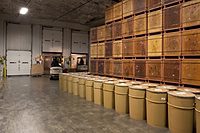Sunny location aids distribution center's sustainability efforts
In recent years, California has had difficulties keeping up with electrical energy demand.

Occasional brownouts or blackouts occur, and electricity costs more than twelve cents per kilowatt-hour (according to the US government’s Electric Power Monthly), making it one of the more expensive states to operate plants and refrigerated warehouses.
Fresh & Easy Neighborhood Market looked for a solution to offset California’s high electrical rates and be a good environmental steward as well. While Fresh & Easy prides itself in using natural sunlight to reduce lighting costs in its supermarkets, the company also found it could save electricity by filling a large section of its 825,000 sq.-ft. distribution center’s roof in Riverside, CA with photovoltaic (solar) cells. According to Fresh & Easy’s CEO Tim Mason, “We try to be thoughtful in how we operate as a business, including being considerate about our impact on the environment. It only seems natural to use California’s remarkable sunshine to power our distribution center.”
The privately funded solar panel installation occupies approximately the size of five football fields, or 500,000 sq. ft. of roof space and is currently one of the largest installations in North America. The installation was not cheap at $13 million, but according to Mason, “The solar roof is rated for peak power of 2 megawatts and it will produce over 2.6 million kilowatt hours per annum, providing nearly a fifth of the depot’s power supply.” That’s a saving of 1,200 tons of carbon dioxide emissions each year. Since going live in March, the solar panels have provided more than 2,100 MWh of electricity-enough to power more than 300 homes.
“At times, the meter at the facility even runs backward because we are producing so much solar energy,” says Mason. The distribution center requires about 1.37 MW daily to keep it operating. The solar panels supplement the electricity from the power grid. A real-time, on-line data acquisition system hosted at www.freshandeasy.com/greenbuilding.aspx shows the current generating state of the solar array and its contribution to the overall power needs of the distribution center.

Fresh & Easy has 500,000 sq. ft. of solar cells installed on its 825,000-sq. ft. distribution center. The inset shows the real-time results of the solar array output via the Web. Source: Fresh & Easy.
Occasional brownouts or blackouts occur, and electricity costs more than twelve cents per kilowatt-hour (according to the US government’s Electric Power Monthly), making it one of the more expensive states to operate plants and refrigerated warehouses.
Fresh & Easy Neighborhood Market looked for a solution to offset California’s high electrical rates and be a good environmental steward as well. While Fresh & Easy prides itself in using natural sunlight to reduce lighting costs in its supermarkets, the company also found it could save electricity by filling a large section of its 825,000 sq.-ft. distribution center’s roof in Riverside, CA with photovoltaic (solar) cells. According to Fresh & Easy’s CEO Tim Mason, “We try to be thoughtful in how we operate as a business, including being considerate about our impact on the environment. It only seems natural to use California’s remarkable sunshine to power our distribution center.”
The privately funded solar panel installation occupies approximately the size of five football fields, or 500,000 sq. ft. of roof space and is currently one of the largest installations in North America. The installation was not cheap at $13 million, but according to Mason, “The solar roof is rated for peak power of 2 megawatts and it will produce over 2.6 million kilowatt hours per annum, providing nearly a fifth of the depot’s power supply.” That’s a saving of 1,200 tons of carbon dioxide emissions each year. Since going live in March, the solar panels have provided more than 2,100 MWh of electricity-enough to power more than 300 homes.
“At times, the meter at the facility even runs backward because we are producing so much solar energy,” says Mason. The distribution center requires about 1.37 MW daily to keep it operating. The solar panels supplement the electricity from the power grid. A real-time, on-line data acquisition system hosted at www.freshandeasy.com/greenbuilding.aspx shows the current generating state of the solar array and its contribution to the overall power needs of the distribution center.
Looking for a reprint of this article?
From high-res PDFs to custom plaques, order your copy today!





